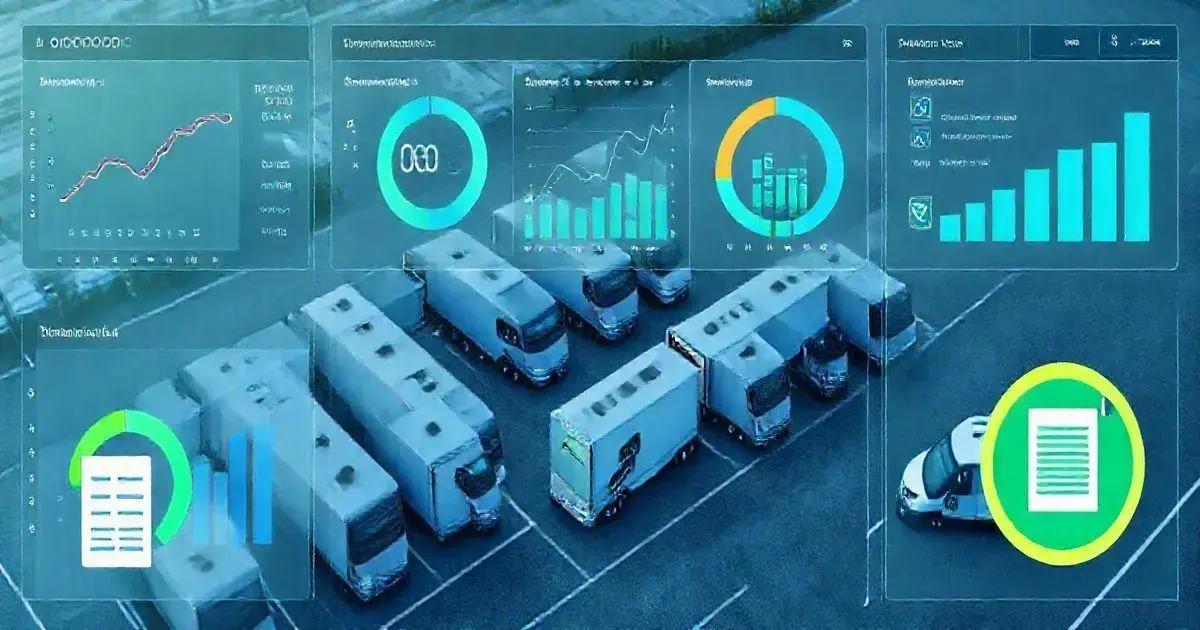Fleet Control Worksheet 7.0: Optimize Your Fleet Management Leave a comment
The Fleet Control Worksheet 7.0 is a vital tool for fleet managers, offering features like performance dashboards, travel and cargo management, tire control, and maintenance tracking to enhance operational efficiency, reduce costs, and ensure compliance with documentation requirements, ultimately improving decision-making and fleet profitability.
The Fleet Control Worksheet 7.0 offers a comprehensive solution for managing your fleet effectively. With features like initial dashboards, maintenance tracking, and detailed cost analysis, this worksheet is designed to optimize your fleet operations.
By utilizing this worksheet, fleet managers can gain insights into various metrics, such as kilometers driven per vehicle, fuel consumption rates, and maintenance costs, leading to better decision-making and resource allocation.
Initial Dashboards Overview
The Initial Dashboards section of the Fleet Control Worksheet 7.0 provides a quick snapshot of your fleet’s performance metrics, allowing you to make informed decisions at a glance. These dashboards are crucial for fleet managers who need to monitor various aspects of their operations efficiently.
Here’s what you can expect:
- KM by Driver: This metric tracks the total kilometers driven by each driver, helping you identify your most active and efficient drivers.
- KM per Vehicle: Understand how much each vehicle is utilized. This information allows you to allocate resources better and schedule maintenance proactively.
- KM per Liter: Monitor fuel efficiency by calculating the kilometers driven per liter of fuel consumed. This insight is vital for reducing operational costs.
- KM per Trip: This metric helps analyze how much distance is covered in each trip, which can inform route planning and improvements.
- Average Consumption per Vehicle: Get an overview of the average fuel consumption for each vehicle, aiding in evaluating performance and efficiency.
- Total General Maintenance: Keep track of all maintenance activities—preventive and corrective—across your fleet, ensuring your vehicles are in top condition.
- Maintenance Cost Average: Calculate the average costs associated with maintenance to identify trends or spikes in spending.
- Tire Maintenance Costs: Track costs associated with tire maintenance, allowing for better budgeting and inventory management.
This initial overview helps fleet managers quickly assess the status of their operations and identify areas for improvement. Utilizing these dashboards effectively can lead to enhanced fleet performance and significant cost savings.

Travel and Cargo Control
The Travel and Cargo Control section of the Fleet Control Worksheet 7.0 is designed to streamline the management of trips and cargo transport operations, ensuring that your fleet runs smoothly and efficiently.
This section encompasses various essential components:
- Cargo Control Linked to Trips: Track the cargo associated with each trip, allowing you to monitor what is being transported and ensuring that each load is accounted for.
- Vehicle Control: Maintain detailed records of which vehicles are assigned to specific trips, helping to optimize vehicle usage and reduce unnecessary wear and tear.
- Driver Control: Keep track of which drivers are assigned to each trip. This accountability not only ensures compliance with regulations but also aids in performance monitoring.
- Supply Control: Manage and monitor the supplies needed for each trip, including fuel, tools, and other necessary items. This ensures that drivers have everything they need before hitting the road.
- Control of All Travel Expenses: Document and analyze all expenses related to each trip. This includes fuel costs, tolls, and maintenance costs incurred during travel. Understanding these expenses is key to managing your budget effectively.
By efficiently overseeing travel and cargo, fleet managers can enhance operational efficiency, minimize costs, and ensure that deliveries are made on time and within budget. This comprehensive approach not only improves resource management but also boosts overall vehicle and driver performance.
Tire Control Management
The Tire Control Management section of the Fleet Control Worksheet 7.0 is crucial for maintaining the safety and efficiency of your fleet. Proper tire management not only extends the lifespan of your tires but also enhances fuel efficiency and reduces operational costs.
This section offers several key features:
- Identification for Each Tire: Keep a detailed record of each tire within your fleet, including its specifications, purchase date, and location on the vehicle. This helps in tracking the performance and wear of each tire individually.
- Tire Change Schedule by KM: Establish a tire change schedule based on the kilometers driven. This proactive approach ensures that tires are replaced before they wear out, reducing the risk of blowouts and accidents.
- Signal of How Much KM is Left to Change the Tire: Utilize alerts based on the remaining kilometers before the next tire change is due. This feature aids in planning maintenance and ensures that drivers are aware of when to expect tire changes.
- Status per Action: Manage the status of each tire by categorizing actions such as allocation to a vehicle, removal from a vehicle, scrapping, or maintenance. This organized tracking facilitates better decision-making regarding tire management.
Effective tire control management contributes to improved vehicle performance, enhanced safety, and significant cost savings over time. Fleet managers can utilize this section to ensure that tire maintenance is conducted regularly and efficiently, ultimately leading to a more reliable fleet.

Maintenance Control Strategies
The Maintenance Control Strategies section of the Fleet Control Worksheet 7.0 is essential for ensuring that vehicles are consistently running at optimal performance levels. A well-planned maintenance strategy reduces downtime, increases safety, and prolongs the lifespan of your fleet.
This section focuses on several crucial aspects:
- Corrective and Preventive Maintenance Type: Differentiate between corrective and preventive maintenance tasks. Corrective maintenance addresses repairs after issues arise, while preventive maintenance aims to prevent problems before they occur through regular inspections and servicing.
- Maintenance by Vehicle: Keep detailed records of all maintenance activities performed on each vehicle. This includes oil changes, filter replacements, tire rotations, and any repairs. By having comprehensive data on each vehicle’s maintenance history, you can better plan future maintenance.
- Maintenance by Mechanical and Electrical Type, Tire, and Lubricants: Categorize maintenance tasks based on the type of service required. This structured approach ensures that all mechanical, electrical, tire, and lubrication needs are systematically addressed.
- Maintenance Cost: Track the costs associated with each maintenance activity. Understanding these costs helps in budgeting and identifying areas where expenses can be reduced.
- Preventive Maintenance Schedule: Create a schedule for regular preventive maintenance tasks. This proactive measure minimizes the risk of breakdowns and keeps vehicles in good working condition.
- Preventive Maintenance Signal: Implement alerts for upcoming preventive maintenance tasks based on mileage or time intervals. This ensures that your fleet is serviced on time, preventing costly repairs down the road.
- Status by: Track the status of maintenance tasks as scheduled, accomplished, or delayed. This visibility allows fleet managers to prioritize work and ensures that nothing falls through the cracks.
By employing these maintenance control strategies, fleet managers can significantly improve the reliability and efficiency of their operations. A focus on regular maintenance not only enhances vehicle safety but also helps to reduce overall costs and improve the return on investment for your fleet.
Cost Analysis and Budgeting
The Cost Analysis and Budgeting section of the Fleet Control Worksheet 7.0 is designed to provide fleet managers with a clear understanding of their expenditures and aid in effective financial planning. This critical section helps in tracking costs related to various aspects of fleet operations, allowing for smarter budgeting and resource allocation.
Key features include:
- Documenting All Travel Expenses: Maintain detailed records of all expenses incurred during trips. This includes fuel costs, tolls, repairs, and maintenance. Having a comprehensive view of travel expenses helps in identifying areas where savings can be made.
- Analyze Fuel Costs: Track and analyze fuel consumption across the fleet. Understanding fuel costs allows fleet managers to make informed decisions about routes, vehicle usage, and fuel-efficient driving practices.
- Maintenance Cost Overview: Keep an eye on the total costs associated with maintenance activities for each vehicle. This data can highlight trends and potential issues before they become significant problems, enabling better budget forecasting.
- Evaluation of Preventive vs. Corrective Maintenance Costs: Compare costs incurred from preventive maintenance against those from corrective maintenance. This analysis helps to justify the investment in preventive measures and understand the long-term financial benefits.
- Cost per Kilometer: Calculate the cost per kilometer driven by each vehicle. This metric is essential for understanding the efficiency of your fleet and can inform decisions on vehicle replacement or optimization.
- Budget Forecasting: Use the collected cost data to create budget forecasts for future periods. This proactive approach helps ensure that sufficient funds are allocated for necessary maintenance, fuel, and other operational costs.
By implementing thorough cost analysis and budgeting practices, fleet managers can enhance financial control, minimize unexpected expenses, and allocate resources effectively. This strategic management of finances not only supports the operational goals of the fleet but also contributes to overall business profitability.

Document Management and Compliance
The Document Management and Compliance section of the Fleet Control Worksheet 7.0 is designed to ensure that all necessary documentation related to your fleet operations is organized, accessible, and compliant with regulatory requirements. Effective document management is crucial for maintaining operational efficiency and minimizing legal risks.
This section includes several vital components:
- Driver Document Control: Track and manage all documents related to your drivers, including licenses, certifications, and training records. Keeping these documents organized helps ensure that all drivers are qualified and comply with industry regulations.
- Vehicle Document Control: Maintain an organized system for all vehicle-related documents, such as registration, insurance, and inspection certificates. This transparency is essential for facilitating compliance checks and audits.
- Compliance Monitoring: Implement processes to regularly review and update documents to ensure compliance with local, state, and federal laws. This proactive approach can prevent costly fines and legal issues.
- Record Retention Policies: Establish clear policies regarding how long documents must be stored and when they can be safely disposed of. Understanding retention requirements helps maintain compliance and reduces clutter.
- Document Accessibility: Ensure that all necessary documents are easily accessible to authorized personnel. This can include digital storage solutions that allow for remote access, improving efficiency and response times.
- Audit Preparedness: Maintain organized records that can be easily retrieved during compliance audits or inspections. Being audit-ready not only helps in passing inspections but also builds credibility with regulatory authorities.
By effectively managing documents and ensuring compliance, fleet managers can mitigate risks, enhance operational efficiency, and maintain a positive reputation. This meticulous attention to detail supports the overall safety and reliability of fleet operations.
Conclusion
In conclusion, the Fleet Control Worksheet 7.0 is an invaluable tool for fleet managers looking to optimize their operations and enhance overall efficiency.
By implementing effective strategies in initial dashboards, travel and cargo control, tire management, maintenance control, cost analysis, and document management, organizations can significantly improve their fleet performance.
Each section of the worksheet is designed to provide comprehensive insights and streamline processes, enabling fleet managers to make informed decisions that lead to cost savings, improved safety, and compliance with regulatory requirements.
Adopting these strategies not only fosters a proactive approach to fleet management but also enhances the sustainability and profitability of operations.
Investing time in managing these aspects will transform how you oversee your fleet, ensuring that you remain competitive in the industry while meeting the needs of your drivers and customers alike.
FAQ – Frequently Asked Questions about Fleet Control Worksheet 7.0
What is the Fleet Control Worksheet 7.0?
The Fleet Control Worksheet 7.0 is a comprehensive tool designed for fleet managers to streamline the management of their fleet operations, including tracking vehicle performance, maintenance, and costs.
How can the worksheet help with maintenance control?
The worksheet provides features for tracking both preventive and corrective maintenance, allowing managers to maintain detailed records, schedule maintenance tasks, and reduce downtime.
What types of costs can I track with the worksheet?
You can track all travel-related expenses, including fuel costs, maintenance costs, and other operational expenses, helping to enhance budget forecasting and financial planning.
Is the document management feature beneficial for compliance?
Yes, the document management feature helps ensure that all driver and vehicle documentation is organized and compliant with regulatory requirements, reducing legal risks.
Can I customize the worksheet for my specific fleet needs?
Yes, the Fleet Control Worksheet 7.0 is designed to be flexible and can be customized to meet the specific needs of your fleet operations.
How do I access technical support if I encounter issues?
Technical support is available via email or phone during business hours, providing assistance with any issues or questions you may have regarding the worksheet.

